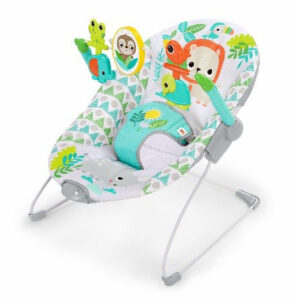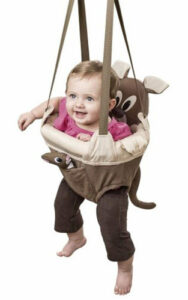How Young Is Too Young? Dynamic Seating and Age
Michelle L. Lange, OTR/L, ABDA, ATP/SMS
In a previous blog, we addressed how to accommodate client growth when using Dynamic Seating components. In this blog, we will address how early Dynamic Seating should be introduced with our youngest clients.
Typically Developing Children
At birth, we have little volitional movement. Movements are not yet smooth, due to incomplete myelination. Some movement is driven by primitive reflexes, such as the rooting reflex to help the baby’s head turn for nursing. As the baby grows and attempts more movement, muscle strength and coordination develop. A newborn does not yet exert enough force to ‘activate’ any type of dynamic component.
Parents begin rocking, walking, and bouncing their children as newborns. Why? It calms them down. Even newborns need movement.
Parents begin rocking, walking, and bouncing their children as newborns. Why? It calms them down. Even newborns need movement.

Bouncy Chair
As the baby grows, parents begin to introduce Dynamic Seating. Now, they don’t call it that. They may call it a bouncy chair. When the infant moves, this reclined seat ‘bounces’ and the baby, having developed Cause and Effect, is motivated to move again as this bouncing is desirable. As baby grows and begins to bear weight on their legs, Grandma may buy a ‘door jumper’ (aka Johnny jump-up). Now being an OT, this Grandma would not be likely to buy this fun device due to safety concerns and the excessive forces placed through the lower extremity joints, but that’s another blog. This ‘dynamic’ device moves in response to the baby’s weight (moving downward) and the baby pushing off the floor through the feet (moving back up).
Even typically developing infants and toddlers are using Dynamic options to provide movement for fun, sensory input, and, in the case of door jumpers, movement against resistance. Once they outgrow these options, they are up and running and providing their own movement, sensory input, and movement against resistance.
Young Children Tracking Movement

Door Jumper
Children with developmental delays are behind in or do not achieve developmental milestones such as rolling, sitting, crawling, and walking. These delays may be seen in a wide array of diagnoses. Some of these children may be able to ‘activate’ a bouncy chair (see our Case Study on Oliver) or devices such as a door jumper, yet may have difficulty providing their own movement, sensory input, and/or movement against resistance as they continue to grow due to developmental delays.
Once these young children begin to use complex rehab equipment, such as adaptive seating systems, adaptive strollers, and wheelchairs, we may observe the following:
- Pushing (extending) against the back of the seating system and / or against the foot support
- Loss of position (typically the pelvis sliding forward) during this extension
- Rocking movement
If these behaviors are noted, movement should be provided. Several adaptive seating systems (Rifton Activity Chair and Etac R82 x:panda) include a Dynamic Back to provide this movement. One adaptive stroller includes a Dynamic Back and a sliding foot platform (Leggero Dyno). Once a wheelchair base is recommended, dynamic components such as a Dynamic Back, Dynamic Footrests, and Dynamic Head Support Hardware can be added to most frames.
How Young is Too Young?
I believe that all children need movement, including newborns. As children get older, they typically provide this movement on their own. For children with developmental delays who are unable to self-generate movement, movement should be introduced within the seating system as soon as complex rehab equipment is ordered – including adaptive seating systems, adaptive strollers, and wheelchairs.
